Compact Homes Dominate Mumbai, But Larger Spaces Gain Traction
Mumbai’s residential real estate market is witnessing a notable shift in buyer preferences, as demand for larger homes gains momentum despite compact units continuing to dominate sales. For years, small apartments ranging between 1BHK and compact 2BHK units have led the market, particularly in the affordable and mid-segment housing categories. However, with changing lifestyle needs, the growing preference for spacious homes has become evident among a rising segment of homebuyers. The pandemic-induced remote work culture, combined with rising disposable incomes and evolving aspirations, has played a crucial role in this trend. This shift is particularly significant in a city like Mumbai, where space is a luxury and property values remain among the highest in the country.
Market Trends: The Demand for Bigger Spaces
While compact homes still drive overall sales volume, developers are witnessing increased demand for larger apartments, particularly in premium micro-markets like South Mumbai, Thane, and the Western Suburbs. Data from industry reports suggests that 2.5BHK and 3BHK apartments have seen a steady rise in absorption rates, particularly among nuclear families and HNIs (High Net-Worth Individuals) looking for enhanced living experiences. This trend aligns with the increasing affordability of larger spaces, as buyers leverage competitive home loan rates and flexible payment schemes offered by developers. Additionally, real estate experts note that buyers are willing to invest in extra space, particularly in projects with modern amenities and superior connectivity.
Sustainability and Urban Planning Concerns
While the growing demand for bigger homes indicates consumer confidence and financial stability, it also raises urban sustainability concerns. Mumbai’s infrastructure is already under immense pressure, with traffic congestion, high population density, and limited land availability posing critical challenges. Expanding residential footprints must align with sustainable development principles, such as eco-friendly construction materials, green-certified buildings, and energy-efficient design. Developers focusing on sustainability are seeing greater traction among environmentally conscious buyers, with initiatives like rainwater harvesting, solar panels, and low-carbon construction techniques gaining popularity. However, the city’s real estate sector still requires stronger regulatory frameworks and incentives for large-scale sustainable housing projects to ensure long-term environmental balance.
Civic and Urban Development Challenges
Despite the positive shift in homebuyer sentiment, Mumbai continues to grapple with affordability issues and civic infrastructure constraints. While premium buyers can afford larger spaces, a significant section of middle-income homebuyers struggle with skyrocketing property prices. Many residents are forced to compromise on location and connectivity to accommodate their spatial needs, often leading to increased urban sprawl. The government’s role in facilitating affordable housing schemes and transit-oriented development projects will be crucial in ensuring that Mumbai’s housing market remains inclusive and accessible. As the city evolves, it must strike a balance between accommodating homebuyer aspirations and maintaining sustainable urban growth.







